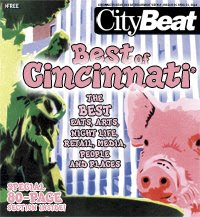Val has asked my to contribute to the Cincy Locavore blog from the farmers point of view so periodically I will post things here about the life of one small farmer (that would be me) and her sustainable farm. To learn more about my farm visit my blog
Winter is here-it is cold, snowy and most everything that is not we covered is dead. This means things have slowed way down for us (
yay!) It is nice to be able to kick back for a month or so before the 80 hour a week grinds starts again.
People want to know what we farmers do in the off season. For us, we spend a lot of November cleaning up stuff like the store, the garden beds, popcorn, catnip, onions. Crunching numbers on the various produce items we grow so we have an idea as to what is selling and what is not selling so we know what seeds to plant for the coming season. Eugene does not do much on the computer so it is me who keeps the blog and website updated and that can be time consuming, especially this year since it looks like Boulder Belt is back in the
CSA biz and that means at some point I need to design an informative
CSA page for the Boulder Belt Website.
December is too often spent removing snow from hoop houses and driveways. It is also the time we put in our main seed order with Johnny's Selected Seeds (our favorite seed house). In the past we have waited until after Christmas to put in our order but there are rumors that there will be seed shortages this year so I believe I will get at least part of the order in in early Dec. or even late November. December is usually the Month that we start the onions and leeks indoors, though this year I believe the onions will be started today or tomorrow (that would be mid November). The reason for moving up the date is due to the fact we have quite a few Copra onion seeds left over from last year and We decided that those should be planted to see if they have strong germination. If they do than we do not need to order more seed. If they do not than we will know by Dec 1st if the seeds are working or not and can get an order into Johnny's early enough to avoid the dreaded back order that can set one back several months.
If December, January and February are mild (which is the
NOAA prediction for us this winter, but I will believe that when I see it) than the crops in the hoop houses will continue to produce pretty much all winter and someone has to go and harvest and package the crops periodically (weekly-as growth slows way down in the winter even if it is relatively warm and sunny). We than sell the greens, leeks, etc., at the Oxford Monthly Winter market and this year the
CSA gets their share as well. We also sell through the store via email appointment and occasionally to a restaurant or Miami University.
If the winter months are cold with a lot of
precip, than most things quit growing until Late Feb and cannot be harvested, the exception to this are the leeks and scallions. Than we sit around twiddling our thumbs waiting on the greens to come back to life. Okay, we don't spend much time thumb twiddling (but we do start craving greens in a big way and are delighted when things are
harvestable again). If it is a snowy winter than we are spending lots of time removing snow from the hoop houses, otherwise they get flattened and are
unuseable and have to be repaired or replaced. this has happened a couple of times to us and incredibly the crops under all the snow and plastic are generally unharmed and producing very well when we finally get to them
What we are doing by Feb is starting seriously seeds indoors. This starts out slowly with around 15 pots of onions and leeks planted in Dec/Jan. Those are followed by the
brassicas-kale, broccoli, cabbages, etc., and lettuces in mid to late Feb. Those crops are repeatedly seeded indoors through April/May so we have a continual harvest April through June/July. By late March we are also starting early tomatoes, peppers, zucchini and melons to be planted in mid April in hoop houses. In April the main crops of tomatoes, peppers, eggplant, celery, celeriac, parsley, flowers, etc., are started which fills up the grow room along with cold frames and hoop houses with thousands of seedlings.
Once the seeds are started we are tied to the farm. The seeds need daily tending-watering, fertilizing, pricking (this means to re pot into a larger container), making soil (we make our own soil mix for seed starting as we have a hard time finding
soiless mixes that don't contain petroleum products or chemical fertilizers. Add to that, we start seeds in
soil blocks and we make our own soil blocks so the
soiless mix has to be just so for it to work for us. Making our own soil blocks means we use very little plastic when starting our seedlings. It probably saves us around a thousand bucks a year as well (of course it increases our work load by at least 100 hours as we have to make a lot of soil and a lot of soil blocks.)
So you can see that we small sustainable farmers really don't have much down time at all. Some day, perhaps, we will quit this idea of winter growing and marketing and will shut the farm down in November and go to the
Caribbean for 4 months.
 Cincinnati Magazine has named Cincinnati Locavore "Best Food Blog" in their Best of the City issue, on newsstands now.
Cincinnati Magazine has named Cincinnati Locavore "Best Food Blog" in their Best of the City issue, on newsstands now.












